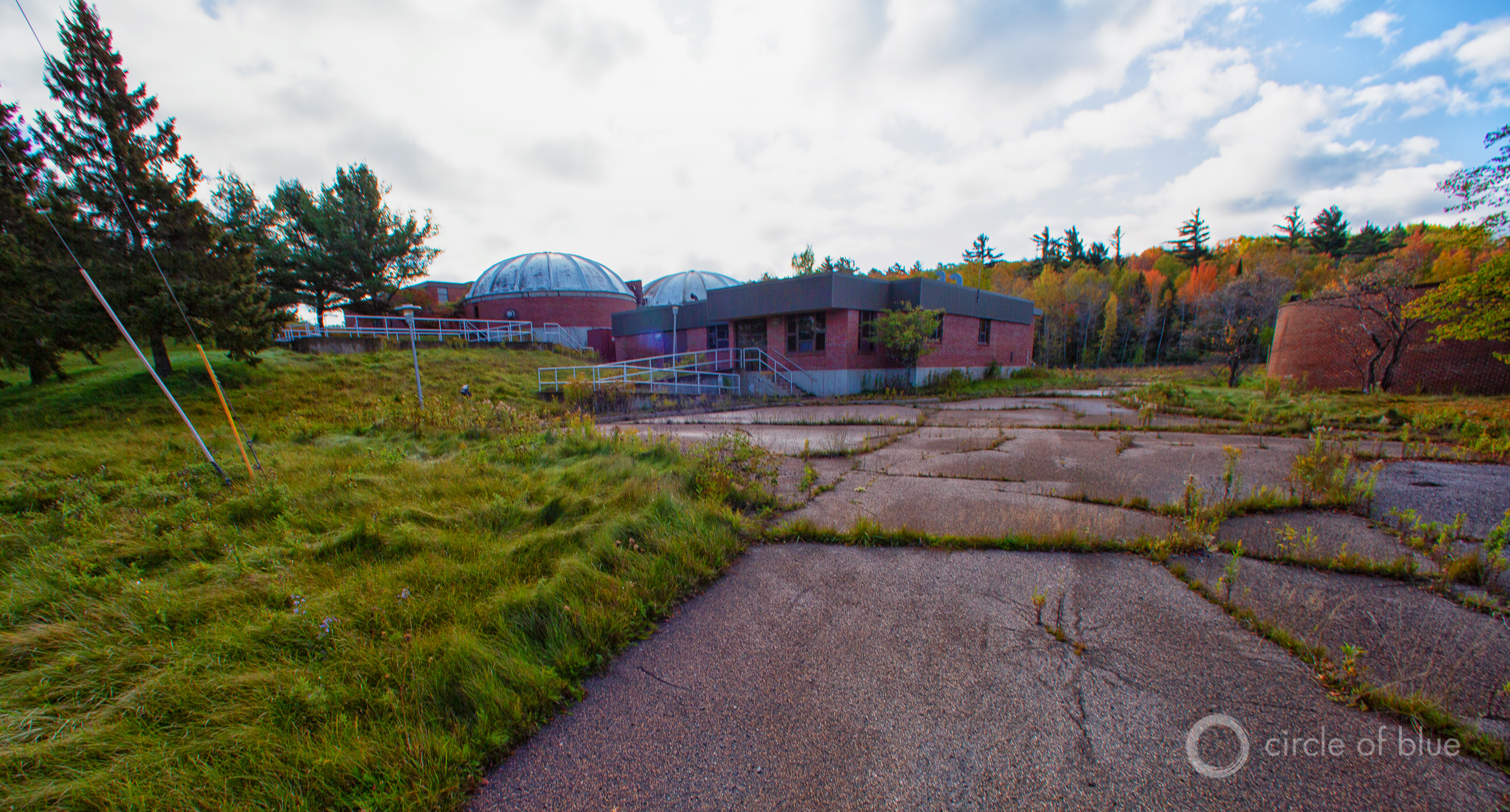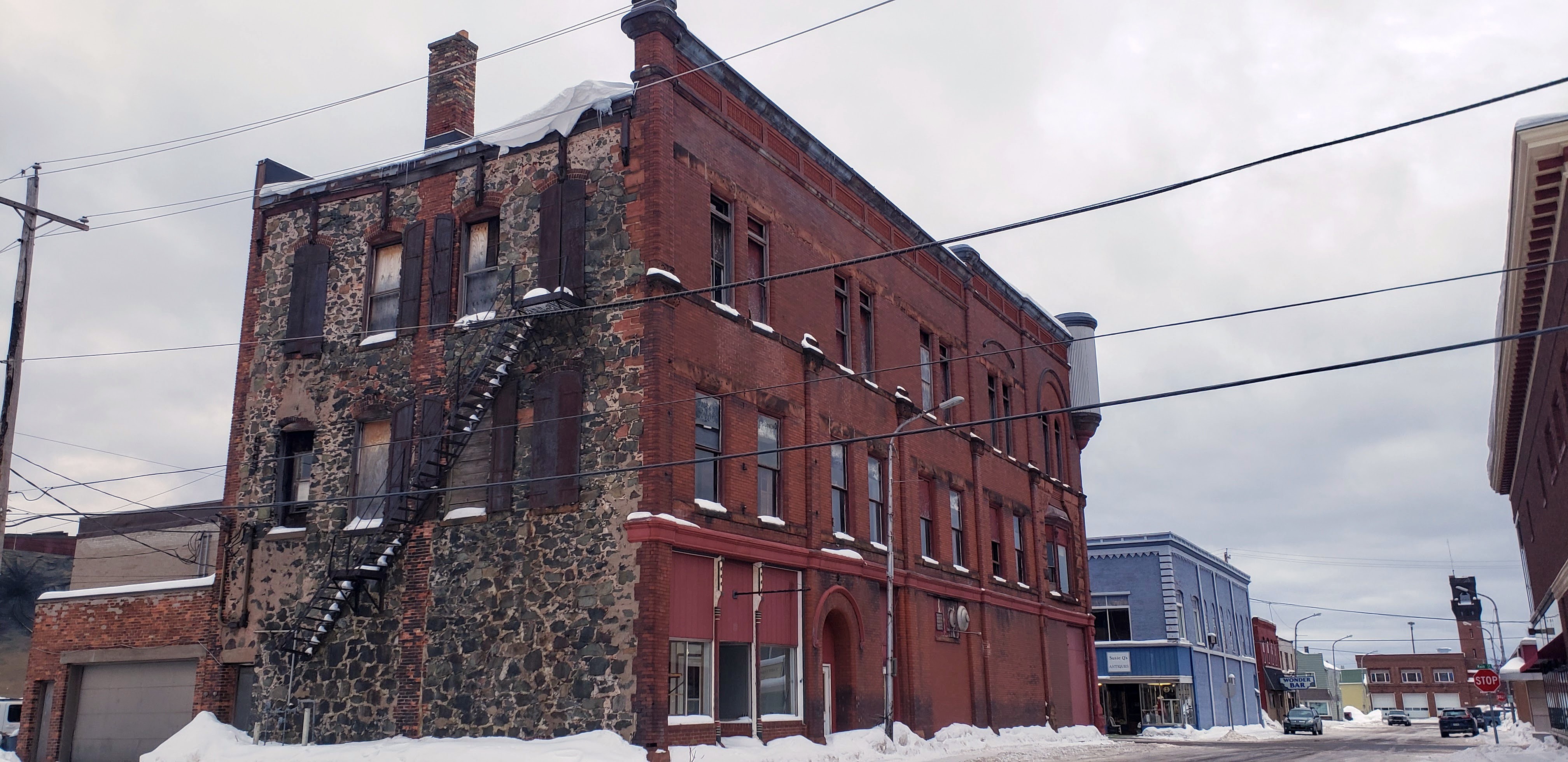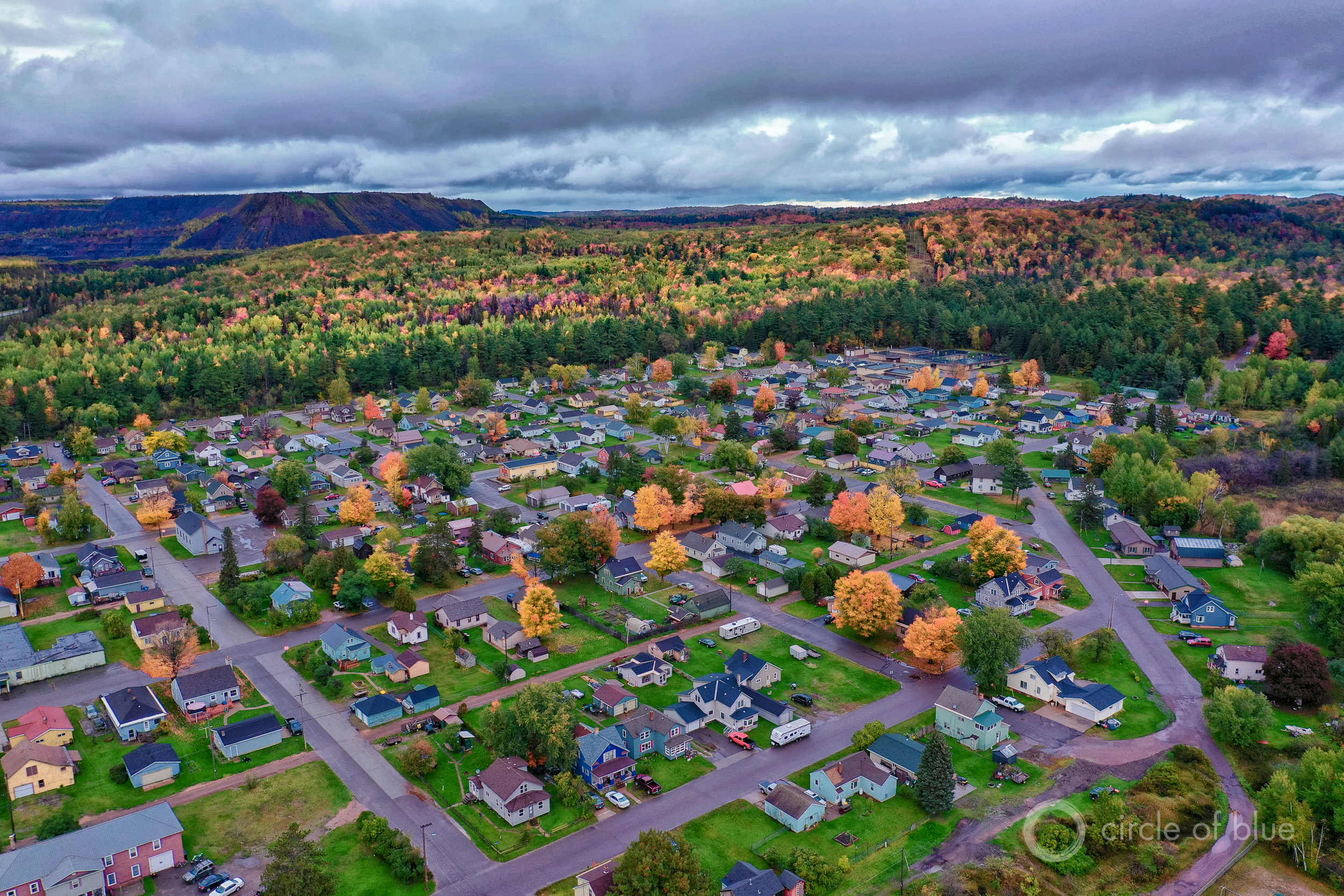
By Brett Walton, Circle of Blue
The Great Lakes News Collaborative includes Bridge Michigan; Circle of Blue; Great Lakes Now at Detroit Public Television; and Michigan Radio, Michigan’s NPR News Leader; who work together to bring audiences news and information about the impact of climate change, pollution, and aging infrastructure on the Great Lakes and drinking water. This independent journalism is supported by the Charles Stewart Mott Foundation. Find all the work HERE.
Craig Cugini, the city manager of Ishpeming, is a calculator by trade. To keep the water system functioning, he computes customer rates and charges, balances a mixture of federal loans and state grants, and keeps an eye on the aging pipes.
Right now the numbers don’t add up.
“I have probably over $10 million worth of sewer projects alone to do in this town, and I don’t have anywhere near $10 million worth of money to do sewer work,” Cugini told Circle of Blue.
It’s not just the sewer pipes that are part of the equation. When laying out a sewer infrastructure work plan, Cugini also needs to account for the cost of road repairs in the historic Upper Peninsula city. “If you tear up all those roads then you have all new roadway and my roadway funds are very limited,” he said.
Though the math that Cugini applies to his work is fairly straightforward, the elements of the serious challenge it encompasses for Ishpeming and other small rural Michigan cities are not. Town managers are balancing immediate needs for new pipes and treatment works with the financial constraints of a resident population that is shrinking, poorer, and older than the rest of Michigan.
This Upper Peninsula town, founded following an iron ore discovery in the 1870s, counts 6,400 residents, down by nearly half since its peak 120 years ago. Now, Ishpeming’s smaller population and grayer residents are being asked to foot the bill for the neglected investments of the 20th century while also envisioning what their town could be in this one.
It’s an expensive challenge that resists solutions. New legislation approved in Washington could help by awarding additional water infrastructure grants to rural towns. At the same time, the state’s changing climate opens another level of concern and calculation.
In the coming decades, as planet-warming greenhouse gases produce increasingly unstable patterns of precipitation and heat across the United States, the Great Lakes region could emerge as a climate refuge. Michigan boasts comparatively ample fresh water reserves and comparatively stable meteorological conditions. Leading analysts at the Rhodium Group speculate that the state could become a haven for people fleeing California’s wildfires, the Gulf Coast’s hurricanes, or Arizona’s heat.
Waves of expat Sun Belters could repopulate Detroit and other cities that operate water and sewer systems built for many more people than are currently using them. Those hypothetical migrants, though, might also land in communities in the Upper Peninsula and the Thumb that are contending with the pressing infrastructure challenges of the moment.

The population of Ishpeming, an Upper Peninsula city founded following an iron ore discovery in the 1870s, is down by nearly half since its peak 120 years ago. Craig Cugini, the city manager, said that he struggles to balance the need for infrastructure improvement while keeping city services affordable for its 6,400 residents. (Photo by Laura Herd/Circle of Blue)
Turning Elsewhere for Help
What Cugini needs to do in Ishpeming is…almost everything. The sewer system requires a complete overhaul in the next decade, thus Cugini’s search for $10 million. For drinking water, the state is determined to rid systems of a public health menace. Removing lead from pipes and plumbing components in the next two decades, which is a goal set by former Gov. Rick Snyder in 2018, would secure a healthier future. But Cugini says that 80 to 90% of his system would need to be replaced under the state’s definition.
“With the amount of money it’s going to cost, I don’t know how we’re going to achieve it,” he said, acknowledging that infrastructure decisions influence household finances. “We’re trying to fight the dynamic of doing what we need to do but making living in the community affordable.”
Building, maintaining, and operating a water and sewer system is generally the most expensive item on a small town’s budget. Those costs are passed on to residents, whose water and sewer rates tend to be higher than their urban counterparts, which benefit from scale effects. The problem is that previous generations, when setting water rates, failed to account for the day that their assets would eventually become liabilities.
“The lifecycle for water infrastructure should be about a hundred years,” Cugini explained. “But nobody for the last hundred years has been collecting the money necessary to replace the water infrastructure. So now you’re at Year 100 trying to start collecting a hundred years’ worth of maintenance costs in order to replace the infrastructure and put another hundred years on it. And that’s kind of where we’re at right now, trying to figure out how to cover all the stuff that wasn’t done in the last hundred years.”
For instance, people in the Huron County community of Bad Axe (population: just under 3,000) pay $115.55 per month for 4,000 gallons of water and sewer. Rates are even higher in Ishpeming, where water and sewer for that level of consumption would be $138.64. Compare that to Grand Rapids, the state’s second largest city, where residents pay $60.69 for the same amount of water and sewer.
The problem of high rates and large fixed costs is compounded when the population shrinks and a large percentage of the people are low-income, says Jane Fitzpatrick of the Eastern Michigan Council of Governments.
“Our population continues to fall,” Fitzpatrick told Circle of Blue. “But the debt service is still there. You still have to pay.”

The tiny unincorporated community of Palmer sits on the opposite side of the Empire mine from Ishpeming. (Photo by J. Carl Ganter/Circle of Blue)
A lifeline for communities like Ishpeming is the Water and Waste Disposal Program run by the U.S. Department of Agriculture’s rural development unit. The program hands out billions of dollars each year for small towns to replace pipes, install new treatment works, and build up their capacity to withstand flooding from heavy rains.
“Grants are critical for the replacement of the system,” Cugini said.
How do the loans help rural viability? “Without that infrastructure in place you’re not going to keep any type of industry or business in those areas,” Tim Neumann, executive director of the Michigan Rural Water Association, told Circle of Blue.
Establishing a rural economic base was the intention of the Water and Waste Disposal Program from the start. The authors of the bill that established the grant and loan program during the Nixon administration were explicit about it.
Sen. Herman Talmadge of Georgia, the chair of the Committee on Agriculture and Forestry at the time, introduced the Rural Development Act of 1972. Explaining the bill to the Senate, he said that rural areas, if they were to grow and prosper and “move forward with the rest of America,” needed more than just credit and investment. They needed the right sorts of investment — and the federal government would be there to help.
“In addition, the new industry must have, for example, an adequate, dependable, and high quality water supply,” Talmadge told his colleagues. “It must have adequate waste disposal systems that will meet modern federal and state pollution control standards.”
Grants and loans from the U.S. Department of Agriculture’s Water and Waste Disposal Program are a lifeline for rural communities in Michigan and elsewhere across the country. Between January 2008 and November 2020, Michigan towns received $963.8 million in USDA water and sewer loans, and $307.1 million in grants. At the same time, many of these areas are seeing declines in population. The Michigan Department of Technology, Management, and Budget, in a 2019 analysis, expects 31 of the state’s 83 counties to lose population in this decade. Most of those counties are in the Upper Peninsula, the Thumb, and northeast Michigan, where USDA loans and grants are an important funding source for water infrastructure. (Map created by Cayla Anderson/Circle of Blue)
In the nearly five decades since that speech, the importance of USDA’s Rural Development unit has only grown. Even as Republican politics are suspicious of federal spending, Republican-leaning areas are direct beneficiaries of assistance that keeps essential services functioning. In fiscal year 2020, Congress allocated $443 million for the rural water and waste disposal grant program and $1.4 billion for the loan program.
Michigan towns have certainly benefited. Between January 2008 and November 2020, they received $963.8 million in USDA water and sewer loans, and $307.1 million in grants.
“USDA grants are absolutely critical for our infrastructure,” Scott Kenney, Crystal Falls township supervisor, told Circle of Blue. “Without them, we’d be pricing ourselves substantially higher.”
The savings are a result not just of grants but also of favorable interest rates on the loans, which can be as low as 1.375% for the poorest communities. Long repayment periods that extend for up to 40 years also shrink the size of annual bills.
David Post, manager of the village of Hillman, told Circle of Blue that water and sewer revenue that the village receives through customer water bills is sufficient to maintain the system, “but if there’s major work, we have to go through USDA.”
Another pair of loan programs for water and sewer infrastructure are funded through the U.S. Environmental Protection Agency and administered by the states, which provide a 20% funding contribution. Those loans tend to go toward projects in larger communities, Neumann said, which is why the USDA program is important.
Acquiring a USDA loan or grant is not automatic. The funds are available to communities of 10,000 people or fewer. To be eligible, water systems must meet financial requirements such as the amount of their revenue that is earned from rates. But the potential savings are worth the paperwork, Cugini said.
Besides low-interest loans, there are other ways to save money on infrastructure. Take the $10 million sewer replacement that’s on the horizon for Ishpeming. There could be a technical fix. Cugini said that flexible liners that are inserted into a sewer pipe and then cured until they harden are an option that would avoid digging up the streets and depleting his roads budget. But liners are an option only if the pipes are not already too brittle and warped.
Are the pipes too brittle? The state wants communities to know that. Figuring out the condition of local water and sewer assets is the objective of the Michigan Infrastructure Council, which was established by an act of the Legislature in 2018. A sub-council focuses on water, sewer, and stormwater systems. It sponsors a tool for communities to assess their systems and chart a course for future investment.
“The intent of the Michigan Infrastructure Council and the self-assessment,” said Fitzpatrick, who is on the water council, “is to have communities plan when they should be making maintenance investments, so they don’t run into a situation where the infrastructure is retirement age and frail” — a situation that Ishpeming is now encountering.
Cugini applied for a drinking water asset management grant from the Michigan Department of Environment, Great Lakes, and Energy (EGLE). The grant would allow him to survey the age of the town’s water mains and investigate the presence of lead components. Most of Ishpeming’s water mains are from the 1950s and 1960s, but at least some date to 1935. Documentation for the older pipes is unreliable, he said.
As with many grant programs, there is more demand than supply. EGLE allocated $36.5 million for the program. It received 301 applications requesting $137 million.

The Cliffs Shaft Mine Museum, in Ishpeming, is a testament to the area’s history of mineral extraction. (Photo by J. Carl Ganter/Circle of Blue)
Playing Catch Up
Even if towns understand the condition of their systems, not all will be able to finance the upgrades on their own. The USDA Rural Development is a lifeline, but it does not have enough length for everyone who is foundering to grab hold.
How to respond to that mismatch is a motivating question for Martin Doyle, a Duke University professor who studies U.S. water systems. His research is a mix of financial metrics and demographic trends that sheds light on local infrastructure needs and the ability of communities to pay for them.
This line of inquiry brought Doyle to unsettling questions about the trajectory of rural living and the role of government assistance. For all the talk of climate havens, the near-term is not promising for many rural areas across the country. They are currently in the throes of out-migration, as are many Michigan counties. The Michigan Department of Technology, Management, and Budget, in a 2019 analysis, expects 31 of the state’s 83 counties to lose population in this decade. Most of those counties are in the Upper Peninsula, the Thumb, and northeast Michigan.
When population declines and economic stagnation happens to a town needing to update its water system, what often occurs is a plea for outside help.
“When an entire region starts to decline, then the challenge really does reach the state and federal level,” Doyle explained during a lecture in January presented by the National Academies of Sciences, Engineering, and Medicine. “Do we want to subsidize and prop up entire regions? Are we willing to have that as a policy of the United States, to continue propping up some of these cities and geographic regions? Or are we willing to say that, as a policy, we are willing to see some of these communities and regions decay? And that is one of the most troubling aspects of this entire research agenda.”
In a separate conversation, Doyle called the affordability of rural water service a “monstrous elephant in the room.”
Answers to the questions that Doyle raises are, right now, incomplete.
President Joe Biden entered office pledging to restore America’s infrastructure. The $1.9 trillion pandemic relief package that Congress approved in early March includes $350 billion in aid to state and local governments, part of which can be used for water and sewer systems. A stand-alone infrastructure bill, which could add billions more, is one of the next items on the president’s agenda.
There could be assistance funneled not just to water systems but to individual customers, as federal programs do for food and energy. Capitol Hill lawmakers started to move in that direction, inserting more than $1.1 billion in the last two coronavirus relief packages to help low-income households pay their water bills.
Instead of propping up failing systems, Congress could require more water and sewer systems to merge with better-run neighboring systems. States like Kentucky, California, and North Carolina are working to ensure that state funding goes to water systems that have adequate technical skills and financial foundations.
More federal money would be a boon to places like Ishpeming, which find themselves caught between eras. “Right now what you’re finding is people are paying water bills to cover the last hundred years and to project how to get ourselves to the next hundred years,” Cugini said. “You feel like everyone’s rates are super high, but it’s where we’re at. Our forefathers didn’t do anything to help us with setting rates to give us pots of money to do work. And so we’re now playing catch up.”
Catch more news on Great Lakes Now:
Priority Shift: Great Lakes exec moves environmental justice to top of list
H2Ohio: Agency directors focus on wetlands, farmer subsidies, replacing lead lines
Save Water, Save Nature: Kids calendar art contest promotes healthy water management
Some cities are turning to natural infrastructure to deal with extreme rain events
API key not valid. Please pass a valid API key.Featured image: Ishpeming shuttered its water treatment plant and joined the Negaunee-Ishpeming Water Authority, which provides wholesale water service to the two cities. (Photo by J. Carl Ganter/Circle of Blue)





